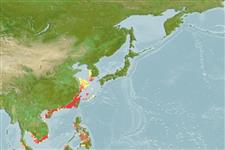Common names from other countries
>
Clupeiformes (Herrings) >
Dorosomatidae (Gizzard shads and sardinellas)
Etymology: Clupanodon: Latin, clupea = sardine, derived from Clupeus = shield; doubtless a reference to the scales covering the body of the fish (Ref. 45335).
More on author: Linnaeus.
Environment: milieu / climate zone / depth range / distribution range
Ecologia
marino; acqua dolce; salmastro; anadromo (Ref. 51243); distribuzione batimetrica 0 - 50 m (Ref. 188). Tropical; 41°N - 6°N, 98°E - 128°E (Ref. 188)
Northwest Pacific: China, apparently south to Viet Nam (Philippine records of Fowler appear doubtful). Eastern Indian Ocean: Specimens were recorded from Phuket Island, Thailand (Andaman Sea).
Size / Peso / Age
Maturity: Lm ? range ? - ? cm
Max length : 26.0 cm SL maschio/sesso non determinato; (Ref. 188)
Spine dorsali (totale) : 0; Spine anali: 0; Raggi anali molli: 22 - 28. Body moderately deep; belly with 16 to 19 (usually 18) + 9 to 12 (usually 10 or 11) total 27 to 31 (usually 29 or 30) scutes; pre-dorsal scutes present, 17 to 26 (usually 20 to 25). gill rakers of first arch at least 3/4 length of gill filaments. Vertebrae 43 to 46 (usually 44 or 45). A dark spot behind gill opening, followed by further spots on flank.
Found in coastal waters and in rivers, presumably tolerating brackish water, if not fully fresh condition. More data needed.
Life cycle and mating behavior
Maturities | Riproduzione | Spawnings | Egg(s) | Fecundities | Larve
Whitehead, P.J.P., 1985. FAO Species Catalogue. Vol. 7. Clupeoid fishes of the world (suborder Clupeoidei). An annotated and illustrated catalogue of the herrings, sardines, pilchards, sprats, shads, anchovies and wolf-herrings. FAO Fish. Synop. 125(7/1):1-303. Rome: FAO. (Ref. 188)
IUCN Red List Status (Ref. 130435)
CITES (Ref. 128078)
Not Evaluated
Threat to humans
Reports of ciguatera poisoning (Ref. 4690)
Human uses
Pesca: commerciale
Strumenti
Special reports
Download XML
Fonti Internet
Estimates based on models
Preferred temperature (Ref.
115969): 24 - 29, mean 27.4 (based on 184 cells).
Phylogenetic diversity index (Ref.
82804): PD
50 = 1.0000 [Uniqueness, from 0.5 = low to 2.0 = high].
Bayesian length-weight: a=0.00933 (0.00531 - 0.01641), b=3.07 (2.92 - 3.22), in cm Total Length, based on LWR estimates for this species & (Sub)family-body (Ref.
93245).
Trophic level (Ref.
69278): 3.1 ±0.3 se; based on size and trophs of closest relatives
Resilienza (Ref.
120179): Alto, tempo minimo di raddoppiamento della popolazione meno di 15 mesi (Assuming tm=1).
Prior r = 1.19, 95% CL = 0.79 - 1.79, Based on 1 data-limited stock assessment.
Fishing Vulnerability (Ref.
59153): Low to moderate vulnerability (27 of 100).
Climate Vulnerability (Ref.
125649): Very high vulnerability (78 of 100).
